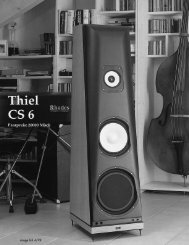Reviewer: John Potis Analog Source: Rega P9 turntable ... - Thiel
Reviewer: John Potis Analog Source: Rega P9 turntable ... - Thiel
Reviewer: John Potis Analog Source: Rega P9 turntable ... - Thiel
You also want an ePaper? Increase the reach of your titles
YUMPU automatically turns print PDFs into web optimized ePapers that Google loves.
Okay, I was stumped. 6moons reviewers aren't asked to review home theater speakers very often. Why then did<br />
<strong>Thiel</strong> approach me to review their new PowerPoint 1.2 with matching SS1 subwoofer? I wasn't sure but what the<br />
heck - I was game. Alas, when I was sent just one pair, I wondered. "Shouldn't I be reviewing an entire multichannel<br />
system?" I was assured that two of them would be fine. Okay.<br />
Home theater speakers? Well, that was my assumption. I mean, two speakers intended for mounting to either the<br />
ceiling in front of you or to the walls behind you - we've just got to be talking theater. Right? Well, that was to be just<br />
the first of a few dispelled untruths. Read on.<br />
I recall first hearing the original PowerPoint a few years ago at CES. I recall a fairly large room with three Power-<br />
Points set across the floor in front of me. I recall that the sound was fine but also somewhat disconcerting. All that<br />
sound coming from small speakers on the floor? The image it brought to mind was akin to the Star Trek teleporters.<br />
The apparatus was on the floor but the images (the bodies) were clearly above them suspended in mid-air. Suspended<br />
by what? In my home, I used the PowerPoint 1.2 on the floor, which was no less disconcerting at first. Imagine<br />
an equipment rack full of gear with almost no speakers flanking it. Strange.<br />
The nuts and bolts of it all<br />
The new version of <strong>Thiel</strong>'s PowerPoint is called the PowerPoint 1.2.<br />
Unlike its predecessor that used a 3/8-inch thick thermoformed<br />
acrylic plastic enclosure, the 1.2 sports a new cast aluminum cabinet<br />
said to offer significant sonic improvement in both clarity and<br />
dynamics. With a newly reshaped chassis, the 1.2 is also sleeker<br />
than its predecessor. As is true for all <strong>Thiel</strong> speakers these days,<br />
the PowerPoint's drivers are made completely in house. While the<br />
coaxial driver array may look similar to that of the PCS at first<br />
glance, appearance is skin deep only. In order to achieve both time<br />
and phase coherence, <strong>Thiel</strong> has been mounting its tweeters inside<br />
the mid-woofer's voice coil for generations now.<br />
That much remains the same. However, unlike the PCS and CS 2.4 that use no electronic crossover between<br />
tweeter and midrange, the array in the PowerPoint 1.2 includes a tweeter that is a separate and self-contained unit<br />
mounted coaxially and coincidently in the center of the woofer. It is the same tweeter first developed for the<br />
$16,000/pr. CS7.2 and said to be a very high output, low distortion design. An electrical crossover network supplies<br />
signal to the tweeter and woofer. According to Jim <strong>Thiel</strong>, "another important point about the PowerPoint drivers, in<br />
this case the [6½-inch] woofer, is that it uses a very shallow diaphragm so as to not degrade the tweeter's output. It<br />
maintains great strength nonetheless by the use of a layer of cast polystyrene foam laminated to the rear of the aluminum<br />
diaphragm. Also, the woofer uses a neodymium magnet --unusual for woofers because of its high cost -- to<br />
provide a large amount of magnetic energy while still being small enough to allow driver mounting very close to the<br />
ceiling. This design element is critical for the functioning of the PowerPoint's boundary reflection reduction operation.<br />
Both drivers also utilize our short coil/long magnetic gap and copper-stabilized motor design for very low distortion."<br />
The PowerPoint 1.2 is said to have a frequency response of ±3dB from 75Hz to 20kHz, a sensitivity of 89 dB @ 2.8<br />
V-1m, phase response within ±10 degrees of minimum and a 4-ohm nominal impedance. Horizontally oriented, the<br />
cabinet's dimensions are 21" deep, 6.5" tall and 12" wide. Weight is 16. <strong>Thiel</strong> recommends amplifiers from 30 to 200<br />
watts. For bass duties, <strong>Thiel</strong> sent along their SS1 subwoofer. By <strong>Thiel</strong> standards, the SS1 is the baby of the family.<br />
By most standards, it's anything but. The 11-inch wide, 17-inch deep and 20-inch tall enclosure holds a 10-inch aluminum<br />
woofer and a 500-watt RMS Class D amplifier and weighs in at a solid 55 pounds. <strong>Thiel</strong> quotes a sensitivity<br />
of 120dB (at one volt) at 1 meter and an acoustic output of up to 99dB at 20Hz and 106dB at 30Hz. Clearly these<br />
figures won't qualify the SS1 as a super-sub in terms of output (you can find woofers with higher output at 20Hz for<br />
a lot less money). But <strong>Thiel</strong>'s emphasis is on quality, not quantity. That's me speaking, not <strong>Thiel</strong>. And in the name of<br />
quality, <strong>Thiel</strong> has taken some unusual steps.<br />
First, in order to spare the user the trial-and error process<br />
of mating their subwoofer with their <strong>Thiel</strong> speakers, <strong>Thiel</strong><br />
has designed the PX series of passive crossovers - one<br />
for every model of <strong>Thiel</strong> speaker made. No more fumbling<br />
around looking for that correct low-pass point. No more<br />
experimenting looking for correct subwoofer phase. <strong>Thiel</strong><br />
has done all the work for you. The brushed aluminum and<br />
extremely attractive PX02 crossover measures 2 inches<br />
high, 7 inches wide and 6.5 inches deep. More on the<br />
PX02 later.




